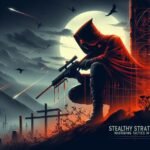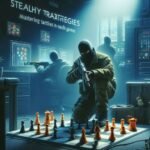Welcome to “Invisible Intrigue,” a deep dive into the complex and captivating world of stealth games, where silence is golden and shadows are your closest allies. This guide explores the subtle art of stealth gameplay, focusing on how players can unravel secrets and uncover hidden narratives within their favorite games. Stealth games often layer their gameplay with intricate storylines and puzzles that require more than just tactical prowess; they demand a keen eye for detail and an analytical mind. Whether you’re sneaking through enemy lines or deciphering cryptic clues, mastering these elements can greatly enhance your gaming experience.

Part 1: Understanding the Stealth Genre
Before delving into specific tactics, it’s crucial to grasp what makes stealth games uniquely challenging and engaging.
Core Mechanics of Stealth Games
Stealth games emphasize avoiding detection and minimizing combat in favor of sneaking, hiding, and using the environment to your advantage. Understanding game mechanics like sight lines, noise levels, and enemy behavior patterns is essential.
Narrative Complexity
Many stealth games are built around complex narratives where secrets and subplots abound. Paying close attention to dialogue, background details, and even seemingly minor characters can reveal crucial information and unlock additional story layers.
Part 2: Mastering Stealth Mechanics
Effective stealth is more than staying out of sight; it involves manipulating the game environment and understanding its mechanics deeply.
Leveraging Darkness and Shadows
Learn how to use darkness and shadows to remain unseen. Most stealth games provide visual cues to indicate how visible you are to enemies. Use this to navigate and plan your moves strategically.
Silent Movement and Distractions
Master the art of moving silently and using distractions to manipulate enemy movements. Tools like suppressed weapons, throwable objects, or noise-making devices can divert attention, allowing you to move freely or access restricted areas.
Part 3: Decrypting the Secrets
Intriguing puzzles and hidden secrets are staples in stealth games, providing depth and rewarding intellectual curiosity.
Clue Gathering and Puzzle Solving
Engage with every element of the game to gather clues. This could mean hacking computers, reading documents, or listening to NPC (non-player character) conversations to piece together passwords, codes, or uncover hidden agendas.
Environmental Storytelling
Pay attention to the environment as it often tells a story of its own. Artifacts, architecture, and even room layouts can provide insights into the game’s backstory or clues that are vital for progression.
Part 4: Advanced Strategy and Adaptation
As you advance in skill, your strategies must also evolve to tackle more complex scenarios and challenges.
Adaptive Tactics
Stealth games often adjust to player actions, making adaptive tactics crucial. Learn to change your approach based on enemy behavior changes, such as increased patrols or new security measures.
Integrating Technology and Tools
Utilize advanced technology and tools offered within the game. Drones for surveillance, hacking tools for accessing secure systems, and advanced optics can provide new ways of interacting with the environment and uncovering secrets.
Part 5: Multiplayer and Cooperative Stealth
Some stealth games offer multiplayer modes, where coordination and communication become as important as individual skill.
Coordinated Team Play
Work closely with teammates, sharing information, and coordinating movements to tackle objectives that would be impossible alone. This requires clear communication and precise timing.
Leveraging Multiple Perspectives
In multiplayer modes, use the varying perspectives and abilities of different players to gain a comprehensive understanding of the environment and enemy positioning, unlocking new strategies for uncovering secrets.










